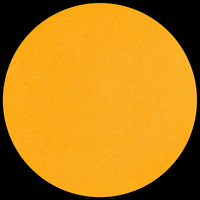With summer heat and humidity making outdoor activities pretty miserable, it is hard to take any talk of a coming global cooling seriously. But the signs are already starting to show themselves in the sun.
As I write this, the sun is completely free of any sunspots and has been sunspot free for a week so far. The last time sunspots vanished for a whole week was in Dec. 2010–a time when the sun was bouncing back from a long Solar Minimum. In this case, the current 8 day absence is a sign that a  new Solar Minimum is coming. Sunspots are the product of magnetic activity inside the Sun, and they appear as darker, cooler areas on the star's surface.
new Solar Minimum is coming. Sunspots are the product of magnetic activity inside the Sun, and they appear as darker, cooler areas on the star's surface.
You might think that they would cause less light to reach Earth, but the areas around the sunspot brighten up, more than compensating for the dark areas. As a result, there's a simple relationship: the more sunspots, the more solar output reaches Earth. Normally, sunspots come and go with the 11-year long solar cycle—more during peak activity, less during the Sun's quieter times. But superimposed on that cycle are longer-term trends in activity that we don't understand very well. For example, solar activity has been trending downward since the 1980s, and it's not entirely clear why. But it's still much more active than it was during a roughly 70-year period around 1700, when the Sun experienced what's called the Maunder Minimum, with very few sunspots visible the entire time.
That period happened to coincide with the Little Ice Age, which saw global temperatures dip and glaciers advance, with Europe experiencing notably colder weather. During this time, temperatures were particularly low over continents in the Northern hemisphere (especially in winter). It has long been suspected that the low solar activity during the Maunder Minimum was one of the causes of the Little Ice Age, although other factors like a small drop in greenhouse gas concentrations around 1600 and strong volcanic eruptions during that time likely played a role as well. As a side note, today, there are approximately 42 active volcanoes around the globe.  Solar physicists do not yet understand how an extended solar-activity low like the Maunder Minimum arises. Yet, recent observations show unusual behavior of the Sun ongoing during the current cycle 24, including a missing zonal wind flow within the Sun, decreasing magnetic field strength of sunspots and lower activity around the poles of the Sun. The current solar cycle 24 is the lowest sunspot cycle in 100 years and the third in a trend of diminishing sunspot cycles. These observations have prompted some scientists to suggest that the Sun might enter a new Maunder-like minimum after the current 11-year cycle ends around 2020 or so. If the theory of coming global cooling proves to be accurate, it may affect all of us in coming years.
Solar physicists do not yet understand how an extended solar-activity low like the Maunder Minimum arises. Yet, recent observations show unusual behavior of the Sun ongoing during the current cycle 24, including a missing zonal wind flow within the Sun, decreasing magnetic field strength of sunspots and lower activity around the poles of the Sun. The current solar cycle 24 is the lowest sunspot cycle in 100 years and the third in a trend of diminishing sunspot cycles. These observations have prompted some scientists to suggest that the Sun might enter a new Maunder-like minimum after the current 11-year cycle ends around 2020 or so. If the theory of coming global cooling proves to be accurate, it may affect all of us in coming years.
In my next post, I will tell you of times before the “Little Ice Age” when it was even warmer on earth than it is now. Feel free to post comments and be sure to hit the “Like” button at the end of this post.






